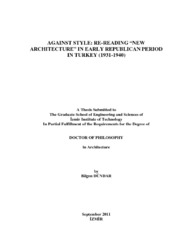Please use this identifier to cite or link to this item:
https://hdl.handle.net/11147/2890Full metadata record
| DC Field | Value | Language |
|---|---|---|
| dc.contributor.advisor | Yücel, Şebnem | - |
| dc.contributor.author | Dündar, Bilgen | - |
| dc.date.accessioned | 2014-07-22T13:48:33Z | - |
| dc.date.available | 2014-07-22T13:48:33Z | - |
| dc.date.issued | 2011 | - |
| dc.identifier.uri | http://hdl.handle.net/11147/2890 | - |
| dc.description | Thesis (Doctoral)--İzmir Institute of Technology, Architecture, İzmir, 2011 | en_US |
| dc.description | Includes bibliographical references (leaves: 187-199) | en_US |
| dc.description | Text in English; Abstract: Turkish and English | en_US |
| dc.description | xii, 199 leaves | en_US |
| dc.description.abstract | This dissertation is intended as a contribution to the understanding of modernization in the early Republican period (ERP) architecture, namely including the neglected attitudes. It criticizes the stylistic periodizations such as "National Style" and "International Style" and rigid classifications such as classifications of Sedad Hakkı Eldem only as the forerunner of national architecture and Seyfi Arkan only as the forerunner of the international architecture in Turkey. This study aims to transcend these reified categories by presenting the varieties and contradictory approaches that existed in architectural theory and practice. This dissertation aims to develop a new reading of the ERP architecture by questioning the categories that were constructed by the first generation of architectural historians who produced their texts between 1973 and 1983. The main aim of this dissertation is to show simultaneous existence of different modernities in the ERP architecture. By revealing different understandings of new architecture in architectural theory, architectural pedagogy and architectural practice, this dissertation focuses on the heterogeneity of the architectural milieu. The first generation of architectural historians constructed the ERP architecture with Euro-centric set of theories, and with conventions such as categorizations and stylistic periodizations. They also read that periodʼs architecture within the frame of the nation-building process. In their texts, the architecture followed a linear and progressive modernization process, paralleling the nation-building process. By tracing the different understandings of modern architecture in architectural theory and tracing different tendencies of architects in architectural practice, this dissertation aims to question not only the categorizations and stylistic periodizations, but also this linear and progressive modernization ideal. | en_US |
| dc.language.iso | en | en_US |
| dc.publisher | Izmir Institute of Technology | en_US |
| dc.rights | info:eu-repo/semantics/openAccess | en_US |
| dc.subject | Architectural historiography | en_US |
| dc.subject.lcsh | Architecture--Turkey--History--20th century | en |
| dc.title | Against Style: Re-Reading "new Architecture" in Early Republican Period in Turkey (1931-1940) | en_US |
| dc.type | Doctoral Thesis | en_US |
| dc.institutionauthor | Dündar, Bilgen | - |
| dc.department | Thesis (Doctoral)--İzmir Institute of Technology, Architecture | en_US |
| dc.relation.publicationcategory | Tez | en_US |
| dc.identifier.wosquality | N/A | - |
| dc.identifier.scopusquality | N/A | - |
| item.openairecristype | http://purl.org/coar/resource_type/c_18cf | - |
| item.cerifentitytype | Publications | - |
| item.fulltext | With Fulltext | - |
| item.languageiso639-1 | en | - |
| item.grantfulltext | open | - |
| item.openairetype | Doctoral Thesis | - |
| Appears in Collections: | Phd Degree / Doktora | |
Files in This Item:
| File | Description | Size | Format | |
|---|---|---|---|---|
| 413220.pdf | DoctoralThesis | 8.32 MB | Adobe PDF |  View/Open |
CORE Recommender
Page view(s)
296
checked on Apr 28, 2025
Download(s)
386
checked on Apr 28, 2025
Google ScholarTM
Check
Items in GCRIS Repository are protected by copyright, with all rights reserved, unless otherwise indicated.